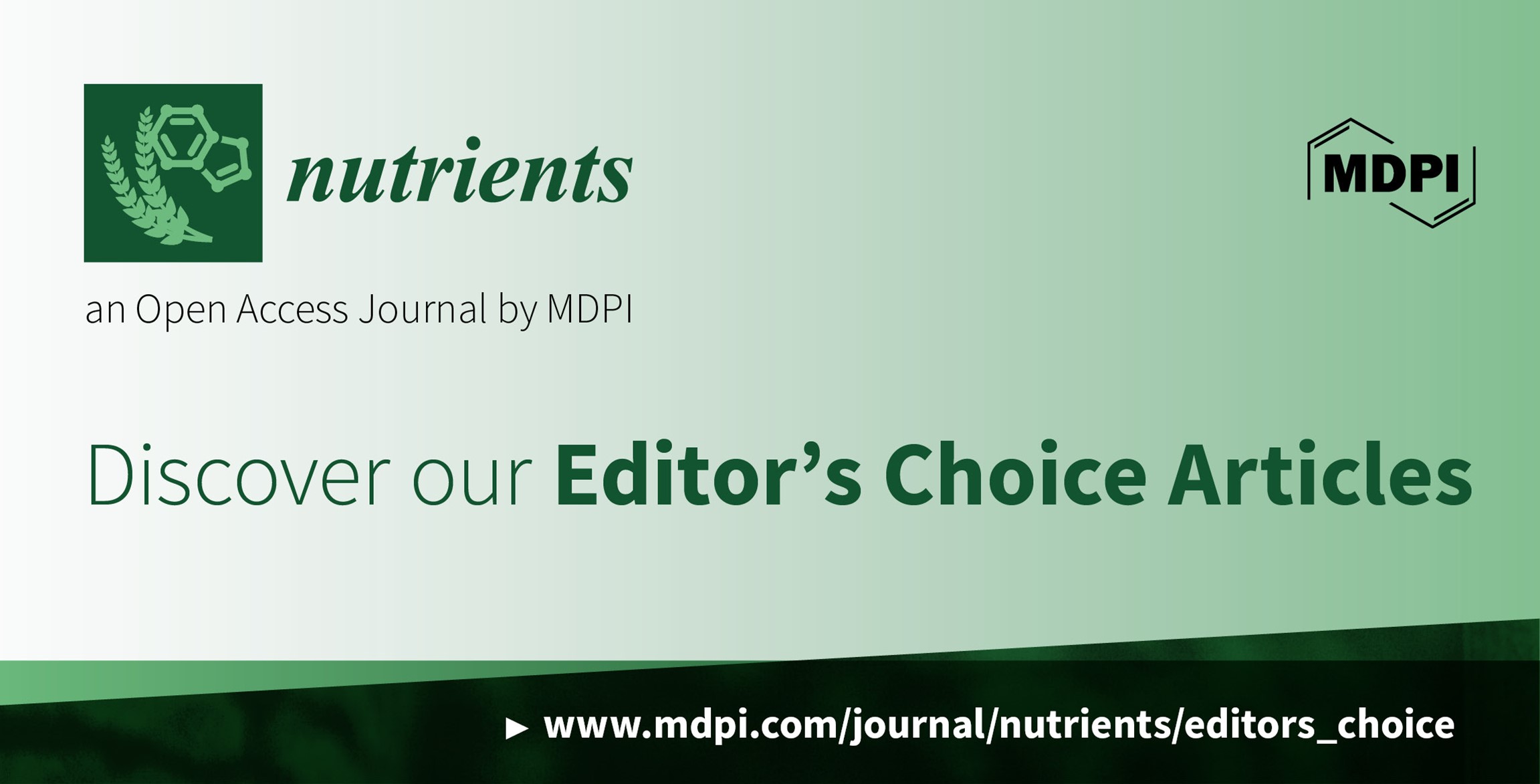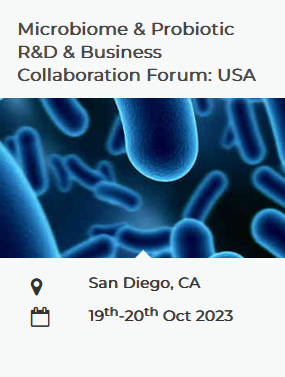-
 Virgin Olive Oil Ranks First in a New Nutritional Quality Score Due to Its Compositional Profile
Virgin Olive Oil Ranks First in a New Nutritional Quality Score Due to Its Compositional Profile -
 High-Dose Spermidine Supplementation Does Not Increase Spermidine Levels in Blood Plasma and Saliva of Healthy Adults: A Randomized Placebo-Controlled Pharmacokinetic and Metabolomic Study
High-Dose Spermidine Supplementation Does Not Increase Spermidine Levels in Blood Plasma and Saliva of Healthy Adults: A Randomized Placebo-Controlled Pharmacokinetic and Metabolomic Study -
 Probiotics Supplementation Attenuates Inflammation and Oxidative Stress Induced by Chronic Sleep Restriction
Probiotics Supplementation Attenuates Inflammation and Oxidative Stress Induced by Chronic Sleep Restriction -
 Dried Fruits, Nuts, and Cancer Risk and Survival: A Review of the Evidence and Future Research Directions
Dried Fruits, Nuts, and Cancer Risk and Survival: A Review of the Evidence and Future Research Directions
Journal Description
Nutrients
Nutrients
is a peer-reviewed, open access journal of human nutrition published semimonthly online by MDPI. The Asia Pacific Nutrigenomics Nutrigenetics Organisation (APNNO), Italian Society for Pediatric Nutrition and Gastroenterology (SIGENP), Nutrition Society of New Zealand (NSNZ), Ocular Wellness & Nutrition Society (OWNS) and others are affiliated with Nutrients and their members receive a discount on article processing charges.
- Open Access— free for readers, with article processing charges (APC) paid by authors or their institutions.
- High Visibility: indexed within Scopus, SCIE (Web of Science), PubMed, MEDLINE, PMC, Embase, PubAg, AGRIS, and other databases.
- Journal Rank: JCR - Q1 (Nutrition & Dietetics) / CiteScore - Q1 (Nutrition and Dietetics)
- Rapid Publication: manuscripts are peer-reviewed and a first decision is provided to authors approximately 14.7 days after submission; acceptance to publication is undertaken in 2.6 days (median values for papers published in this journal in the first half of 2023).
- Recognition of Reviewers: reviewers who provide timely, thorough peer-review reports receive vouchers entitling them to a discount on the APC of their next publication in any MDPI journal, in appreciation of the work done.
- Companion journal: Dietetics
Impact Factor:
5.9 (2022);
5-Year Impact Factor:
6.6 (2022)
Latest Articles
Phenylalanine Tolerance over Time in Phenylketonuria: A Systematic Review and Meta-Analysis
Nutrients 2023, 15(16), 3506; https://doi.org/10.3390/nu15163506 - 08 Aug 2023
Abstract
In phenylketonuria (PKU), natural protein tolerance is defined as the maximum natural protein intake maintaining a blood phenylalanine (Phe) concentration within a target therapeutic range. Tolerance is affected by several factors, and it may differ throughout a person’s lifespan. Data on lifelong Phe/natural
[...] Read more.
In phenylketonuria (PKU), natural protein tolerance is defined as the maximum natural protein intake maintaining a blood phenylalanine (Phe) concentration within a target therapeutic range. Tolerance is affected by several factors, and it may differ throughout a person’s lifespan. Data on lifelong Phe/natural protein tolerance are limited and mostly reported in studies with low subject numbers. This systematic review aimed to investigate how Phe/natural protein tolerance changes from birth to adulthood in well-controlled patients with PKU on a Phe-restricted diet. Five electronic databases were searched for articles published until July 2020. From a total of 1334 results, 37 articles met the eligibility criteria (n = 2464 patients), and 18 were included in the meta-analysis. The mean Phe (mg/day) and natural protein (g/day) intake gradually increased from birth until 6 y (at the age of 6 months, the mean Phe intake was 267 mg/day, and natural protein intake was 5.4 g/day; at the age of 5 y, the mean Phe intake was 377 mg/day, and the natural protein intake was 8.9 g/day). However, an increase in Phe/natural protein tolerance was more apparent at the beginning of late childhood and was >1.5-fold that of the Phe tolerance in early childhood. During the pubertal growth spurt, the mean natural protein/Phe tolerance was approximately three times higher than in the first year of life, reaching a mean Phe intake of 709 mg/day and a mean natural protein intake of 18 g/day. Post adolescence, a pooled analysis could only be performed for natural protein intake. The mean natural protein tolerance reached its highest (32.4 g/day) point at the age of 17 y and remained consistent (31.6 g/day) in adulthood, but limited data were available. The results of the meta-analysis showed that Phe/natural protein tolerance (expressed as mg or g per day) increases with age, particularly at the beginning of puberty, and reaches its highest level at the end of adolescence. This needs to be interpreted with caution as limited data were available in adult patients. There was also a high degree of heterogeneity between studies due to differences in sample size, the severity of PKU, and target therapeutic levels for blood Phe control.
Full article
(This article belongs to the Special Issue Advances in Phenylketonuria (PKU) Nutrition and Diet Research (2nd Edition))
Open AccessArticle
Three-Year School-Based Multicomponent Intervention May Change Fruit and Vegetable Preferences in Primary School Children—A Quasi-Randomized Trial
Nutrients 2023, 15(16), 3505; https://doi.org/10.3390/nu15163505 - 08 Aug 2023
Abstract
Preference could be the trigger for fruit and vegetable (FV) consumption in children and could be modified by appropriate intervention to increase the acceptance of FVs. The primary objective of this study was to investigate the effects of the three-year school-based multicomponent intervention
[...] Read more.
Preference could be the trigger for fruit and vegetable (FV) consumption in children and could be modified by appropriate intervention to increase the acceptance of FVs. The primary objective of this study was to investigate the effects of the three-year school-based multicomponent intervention “Nutri-školica” on the FV preferences of primary school children. It also aimed to explore whether a positive change in FV preferences could lead to an increase in actual FV consumption. The study was conducted in 14 primary schools from the city of Zagreb on 193 children (52.3% boys; age, 7.7 ± 0.4 years; n = 85 in the control group and n = 108 in the intervention group) who completed a preference questionnaire before and after the intervention with a 5-point hedonic smiley-face scale, where 5 means “I like it a lot.” The per-protocol approach was used for data analysis (28.3% of children from the study sample). After the intervention, children in the intervention group (before: 3.1 ± 0.8; after: 3.5 ± 0.8) increased their FV preferences significantly more than children in the control group (before: 3.2 ± 0.8; after: 3.3 ± 0.7). Children’s FV preferences changed most toward the varieties for which they had the least preferences at the beginning of the study. Participation in the intervention had a stronger effect on changing FV intake than change in FV preferences among primary school children. In summary, the present study highlighted that a targeted intervention can increase children’s FV preferences, but that participation in the intervention is substantial for increasing FV intake.
Full article
(This article belongs to the Special Issue School-Based Eating Interventions—Are Students Eating Healthily?)
Open AccessArticle
No Associations between Dairy Intake and Markers of Gastrointestinal Inflammation in Healthy Adult Cohort
by
, , , , and
Nutrients 2023, 15(16), 3504; https://doi.org/10.3390/nu15163504 - 08 Aug 2023
Abstract
Dairy products are a good source of essential nutrients and past reviews have shown associations of dairy consumption with decreased systemic inflammation. Links between dairy intake and gastrointestinal (GI) inflammation are under-investigated. Therefore, we examined associations between reported dairy intake and markers of
[...] Read more.
Dairy products are a good source of essential nutrients and past reviews have shown associations of dairy consumption with decreased systemic inflammation. Links between dairy intake and gastrointestinal (GI) inflammation are under-investigated. Therefore, we examined associations between reported dairy intake and markers of GI inflammation in healthy adults in a cross-sectional observational study, hypothesizing a negative association with yogurt intake, suggesting a protective effect, and no associations with total dairy, fluid milk, and cheese intake. Participants completed 24-h dietary recalls and a food frequency questionnaire (FFQ) to assess recent and habitual intake, respectively. Those who also provided a stool sample (n = 295), and plasma sample (n = 348) were included in analysis. Inflammation markers from stool, including calprotectin, neopterin, and myeloperoxidase, were measured along with LPS-binding protein (LBP) from plasma. Regression models tested associations between dairy intake variables and inflammation markers with covariates: age, sex, and body mass index (BMI). As yogurt is episodically consumed, we examined differences in inflammation levels between consumers (>0 cup equivalents/day reported in recalls) and non-consumers. We found no significant associations between dairy intake and markers of GI inflammation. In this cohort of healthy adults, dairy intake was not associated with GI inflammation.
Full article
(This article belongs to the Special Issue Dietary Components and Immune Function)
►▼
Show Figures
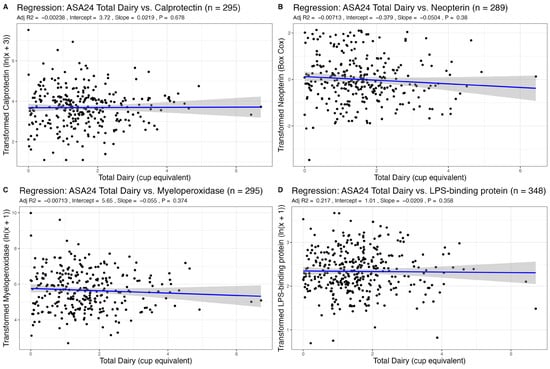
Figure 1
Open AccessReview
The Microbiome and Protein Carbamylation: Potential Targets for Protein-Restricted Diets Supplemented with Ketoanalogues in Predialysis Chronic Kidney Disease
by
, , , , , and
Nutrients 2023, 15(16), 3503; https://doi.org/10.3390/nu15163503 - 08 Aug 2023
Abstract
In chronic kidney disease (CKD), metabolic derangements resulting from the interplay between decreasing renal excretory capacity and impaired gut function contribute to accelerating disease progression and enhancing the risk of complications. To protect residual kidney function and improve quality of life in conservatively
[...] Read more.
In chronic kidney disease (CKD), metabolic derangements resulting from the interplay between decreasing renal excretory capacity and impaired gut function contribute to accelerating disease progression and enhancing the risk of complications. To protect residual kidney function and improve quality of life in conservatively managed predialysis CKD patients, current guidelines recommend protein-restricted diets supplemented with essential amino acids (EAAs) and their ketoanalogues (KAs). In clinical studies, such an approach improved nitrogen balance and other secondary metabolic disturbances, translating to clinical benefits, mainly the delayed initiation of dialysis. There is also increasing evidence that a protein-restricted diet supplemented with KAs slows down disease progression. In the present review article, recent insights into the role of KA/EAA-supplemented protein-restricted diets in delaying CKD progression are summarized, and possible mechanistic underpinnings, such as protein carbamylation and gut dysbiosis, are elucidated. Emerging evidence suggests that lowering urea levels may reduce protein carbamylation, which might contribute to decreased morbidity and mortality. Protein restriction, alone or in combination with KA/EAA supplementation, modulates gut dysbiosis and decreases the generation of gut-derived uremic toxins associated, e.g., with cardiovascular disease, inflammation, protein energy wasting, and disease progression. Future studies are warranted to assess the effects on the gut microbiome, the generation of uremic toxins, as well as markers of carbamylation.
Full article
(This article belongs to the Special Issue Nutrition Management on Chronic Kidney Diseases)
Open AccessArticle
Folate Deficiency Increased Microglial Amyloid-β Phagocytosis via the RAGE Receptor in Chronic Unpredictable Mild-Stress Rat and BV2 Cells
Nutrients 2023, 15(16), 3501; https://doi.org/10.3390/nu15163501 - 08 Aug 2023
Abstract
Depression is often considered one of the prevalent neuropsychiatric symptoms of Alzheimer’s disease (AD). β-amyloid (Aβ) metabolism disorders and impaired microglia phagocytosis are potential pathological mechanisms between depression and AD. Folate deficiency (FD) is a risk factor for depression and AD. In this
[...] Read more.
Depression is often considered one of the prevalent neuropsychiatric symptoms of Alzheimer’s disease (AD). β-amyloid (Aβ) metabolism disorders and impaired microglia phagocytosis are potential pathological mechanisms between depression and AD. Folate deficiency (FD) is a risk factor for depression and AD. In this study, we used a chronic unpredictable mild stress (CUMS) rat model and a model of Aβ phagocytosis by BV2 cells to explore the potential mechanisms by which FD affects depression and AD. The results revealed that FD exacerbated depressive behavior and activated microglia in CUMS rats, leading to an increase in intracellular Aβ and phagocytosis-related receptors for advanced glycation end products (RAGE). Then, in vitro results showed that the expression of the RAGE receptor and M2 phenotype marker (CD206) were upregulated by FD treatment in BV2 cells, leading to an increase in Aβ phagocytosis. However, there was no significant difference in the expression of toll-like receptor 4 (TLR4) and clathrin heavy chain (CHC). Furthermore, when using the RAGE-specific inhibitor FPS-ZM1, there was no significant difference in Aβ uptake between folate-normal (FN) and FD BV2 cell groups. In conclusion, these findings suggest FD may promote microglia phagocytosis Aβ via regulating the expression of RAGE or microglia phenotype under Aβ treatment.
Full article
(This article belongs to the Section Micronutrients and Human Health)
►▼
Show Figures

Figure 1
Open AccessArticle
Prevalence of Malnutrition and Associated Factors in Older Patients with Rheumatoid Arthritis: A Cross-Sectional Study
by
, , , , , , , , , , and
Nutrients 2023, 15(16), 3500; https://doi.org/10.3390/nu15163500 - 08 Aug 2023
Abstract
Objective: To describe the frequency of malnutrition in older patients with rheumatoid arthritis (RA) and investigate associated risk factors. Methods: This multicenter, cross-sectional study included participants aged ≥65 years who met the 2010 ACR/EULAR criteria for RA. Nutritional status was assessed using the
[...] Read more.
Objective: To describe the frequency of malnutrition in older patients with rheumatoid arthritis (RA) and investigate associated risk factors. Methods: This multicenter, cross-sectional study included participants aged ≥65 years who met the 2010 ACR/EULAR criteria for RA. Nutritional status was assessed using the Mini Nutritional Assessment Short Form (MNA-SF) and based on variables, such as albumin level, the Geriatric Nutritional Risk Index (GNRI), and vitamin D. Data were also collected on epidemiological variables, inflammatory disease activity, quality of life, physical function, and frailty. Multivariate models were used to study factors associated with nutritional status. Results: The study population comprised 76 RA patients aged ≥65 years, of whom 68.4% had a normal nutritional status, and 31.5% had an impaired nutritional status: 28.9% were at risk of malnutrition, and 2.6% were malnourished. Additionally, 10% had albumin levels <3.8 g/L. Patients with impaired nutritional status had poorer quality of life and physical function. The factors associated with compromised nutritional status (OR [95% CI]) were age (1.0 [1.0–1.1]; p = 0.035), DAS28-ESR (1.8 [1.0–3.2]; p = 0.024), and EuroQoL-5D-5L (0.9 [0.9–0.9]; p = 0.040). Furthermore, the GNRI was associated with the MNA score (0.06 [0.0–0.1]; p = 0.014). Conclusions: Approximately one-third of older patients with RA have impaired nutritional status. Older age, higher inflammatory disease activity, and decreased quality of life are associated with impaired nutritional status. The MNA and GNRI are valuable tools for assessing the nutritional status of patients with RA.
Full article
(This article belongs to the Special Issue Nutritional Regulation of Aging and Age-Related Diseases)
►▼
Show Figures
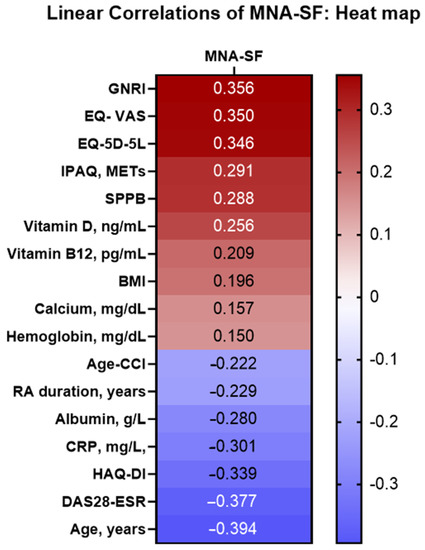
Figure 1
Open AccessArticle
A Randomized, Double-Blind, Placebo-Controlled Study of an Anthocyanin-Rich Functional Ingredient on Cognitive Function and Eye Dryness in Late Adulthood Volunteers: Roles of Epigenetic and Gut Microbiome Modulations
by
, , , and
Nutrients 2023, 15(16), 3499; https://doi.org/10.3390/nu15163499 - 08 Aug 2023
Abstract
Due to the rising demand for supplements targeting cognitive enhancement and dry eye together with the health benefits of anthocyanins, we have developed a functional soup containing an anthocyanin-rich functional ingredient, or “Anthaplex,” and assessed the effects on cognitive function and eye dryness
[...] Read more.
Due to the rising demand for supplements targeting cognitive enhancement and dry eye together with the health benefits of anthocyanins, we have developed a functional soup containing an anthocyanin-rich functional ingredient, or “Anthaplex,” and assessed the effects on cognitive function and eye dryness together with the possible mechanisms. A total of 69 male and female health volunteers were randomized and divided into placebo, D2, and D4 groups. All subjects consumed 120 mL of placebo or functional soup containing “Anthaplex” either at 2 or 4 g per serving per day within 5 min in the morning for eight weeks. The cognitive function, working memory, dry eye, AChE, MAO, MAO-A, MAO-B, and GABA-T activities, BDNF, HAC, HDAC, and DNMT activities, pH, and amount of lactic acid-producing bacteria, particularly Lactobacillus and Bifidobacterium spp. in feces, were determined before intervention and after eight weeks of consumption. Subjects who consumed the “Anthaplex” soup had improved cognitive function, working memory, eye dryness, histone acetylation, ACh E suppression, and BDNF with increased Bifidobacterium spp. but decreased pH in feces. These data suggest that “Anthaplex” improves cognitive function and eye dryness via the modulations of the histone acetylation process, gut microbiome, and cholinergic function.
Full article
(This article belongs to the Special Issue Functional Foods for Gut Health)
►▼
Show Figures
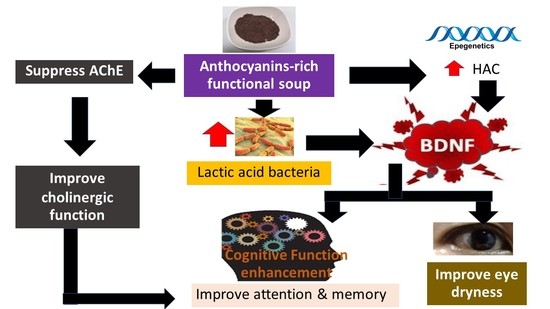
Graphical abstract
Open AccessArticle
Vitamin D Enhances Immune Effector Pathways of NK Cells Thus Providing a Mechanistic Explanation for the Increased Effectiveness of Therapeutic Monoclonal Antibodies
by
, , , , , , and
Nutrients 2023, 15(16), 3498; https://doi.org/10.3390/nu15163498 - 08 Aug 2023
Abstract
Patients with diffuse large cell lymphoma who have an adequate vitamin D supply derive significantly more benefit from immuno-chemotherapy with rituximab than patients with vitamin D deficiency; this is especially true for female patients. We have already been able to show that vitamin
[...] Read more.
Patients with diffuse large cell lymphoma who have an adequate vitamin D supply derive significantly more benefit from immuno-chemotherapy with rituximab than patients with vitamin D deficiency; this is especially true for female patients. We have already been able to show that vitamin D increases the antibody-dependent cytotoxicity (ADCC) of NK cells in a sex-dependent manner, but it is unclear how vitamin D makes NK cells more efficient. Methods: Healthy individuals with vitamin D deficiency were supplemented with vitamin D to sufficient levels. NK cells were isolated from blood samples before and after vitamin D saturation. For transcriptome analysis, we used the Affymetrix Gene-Chip 2.0™. Gene expression analysis as well as supervised and unsupervised pathway analysis were performed. Results: Among others the “NK cell-associated cytotoxicity pathway” increased after vitamin D substitution. Five IFN-α subtypes (2, 4, 6, 7 and 10) and IFN-κ were more highly expressed and are mainly responsible in these pathways. In contrast, the pathway “interferon-gamma response”, as well as other sets in cytokine production and chemotaxis showed a reduction. Toll-like receptor genes (TLR-8, TLR-7, TLR-2) were downregulated and, therefore, are responsible for the decline of these pathways. The same could be shown for the “ubiquitin-ligase” pathway. Conclusions: Increased expression of several IFN-α subtypes may explain the increased ADCC of NK cells in vitamin D-replenished and otherwise healthy subjects. Other regulators of interferon production and ADCC are compensatory upregulated in compensation, such as Toll-like receptors and those of the ubiquitin ligase, and normalize after vitamin D substitution.
Full article
(This article belongs to the Special Issue Regulatory Role of Vitamin D and Its Derivatives in the Immune System)
►▼
Show Figures

Figure 1
Open AccessArticle
Glucosinolates Extracts from Brassica juncea Ameliorate HFD-Induced Non-Alcoholic Steatohepatitis
by
, , , , , and
Nutrients 2023, 15(16), 3497; https://doi.org/10.3390/nu15163497 - 08 Aug 2023
Abstract
Non-alcoholic fatty liver disease (NAFLD) is mainly characterized by excessive fat accumulation in the liver. It spans a spectrum of diseases from hepatic steatosis to non-alcoholic steatohepatitis (NASH), fibrosis, cirrhosis, and hepatocellular carcinoma (HCC). Brassica juncea is rich in glucosinolates and has been
[...] Read more.
Non-alcoholic fatty liver disease (NAFLD) is mainly characterized by excessive fat accumulation in the liver. It spans a spectrum of diseases from hepatic steatosis to non-alcoholic steatohepatitis (NASH), fibrosis, cirrhosis, and hepatocellular carcinoma (HCC). Brassica juncea is rich in glucosinolates and has been proven to possess many potential pharmacological properties, including hypoglycemic, anti-oxidation, anti-inflammatory, and anti-carcinogenic activities. This study aims to investigate whether whole-plant Brassica juncea (WBJ) and its glucosinolates extracts (BGE) have hepatoprotective effects against a high-fat diet (HFD)-induced NAFLD and further explore the mechanism underlying this process in vivo and in vitro. WBJ treatment significantly reduced body fat, dyslipidemia, hepatic steatosis, liver injury, and inflammation; WBJ treatment also reversed the antioxidant enzyme activity to attenuate oxidative stress in HFD-fed rat liver. Moreover, WBJ and BGE enhanced the activation of AMPK to reduce SREBPs, fatty acid synthase, and HMG-CoA reductase but increased the expression of CPT-I and PPARα to improve hepatic steatosis. In addition, WBJ and BGE could ameliorate NAFLD by inhibiting TNF-α and NF-κB. Based on the above results, this study demonstrates that WBJ and BGE ameliorate HFD-induced hepatic steatosis and liver injury. Therefore, these treatments could represent an unprecedented hope toward improved strategies for NAFLD.
Full article
(This article belongs to the Special Issue The Impact of Probiotics/Prebiotics and Functional Foods in Human Health)
►▼
Show Figures
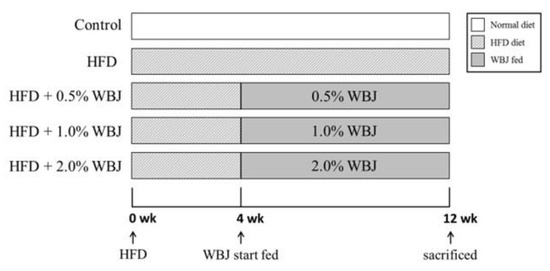
Figure 1
Open AccessArticle
Vitamin B12 Status before and after Outpatient Treatment of Severe Acute Malnutrition in Children Aged 6–59 Months: A Sub-Study of a Randomized Controlled Trial in Burkina Faso
by
, , , , , , , and
Nutrients 2023, 15(16), 3496; https://doi.org/10.3390/nu15163496 - 08 Aug 2023
Abstract
Severe acute malnutrition (SAM) is treated with ready-to-use therapeutic foods (RUTF) containing a vitamin–mineral premix. Yet little is known about micronutrient status in children with SAM before and after treatment. We aimed to investigate vitamin B12 status in children with uncomplicated SAM, aged
[...] Read more.
Severe acute malnutrition (SAM) is treated with ready-to-use therapeutic foods (RUTF) containing a vitamin–mineral premix. Yet little is known about micronutrient status in children with SAM before and after treatment. We aimed to investigate vitamin B12 status in children with uncomplicated SAM, aged 6–59 months in Burkina Faso, before and after treatment with a standard or a reduced dose of RUTF. Blood samples were collected at admission and discharge. Serum B12 was determined with microbiological assay and serum methylmalonic acid (MMA) and total homocysteine (tHcy) were analyzed with gas chromatography-tandem mass spectrometry. B12 status was classified using the combined indicator (3cB12). Among 374 children, the median [interquartile range] age was 11.0 [7.7–16.9] months, and 85.8% were breastfed. Marked or severe B12 deficiency, as judged by 3cB12, decreased from 32% to 9% between admission and discharge (p < 0.05). No differences in B12 status following treatment with either standard (n = 194) or reduced (n = 180) doses of RUTF were observed. Breastfed children showed a lower B12 status (3cB12) than non-breastfed ones (−1.10 vs −0.18, p < 0.001 at admission; −0.44 vs 0.19; p < 0.001 at discharge). In conclusion, treatment of SAM with RUTF improved children’s B12 status but did not fully correct B12 deficiency.
Full article
(This article belongs to the Section Micronutrients and Human Health)
►▼
Show Figures

Figure 1
Open AccessArticle
Indicaxanthin Induces Autophagy in Intestinal Epithelial Cancer Cells by Epigenetic Mechanisms Involving DNA Methylation
by
, , , , , , , , , , , , and
Nutrients 2023, 15(15), 3495; https://doi.org/10.3390/nu15153495 - 07 Aug 2023
Abstract
Autophagy is an evolutionarily conserved process critical in maintaining cellular homeostasis. Recently, the anticancer potential of autophagy inducers, including phytochemicals, was suggested. Indicaxanthin is a betalain pigment found in prickly pear fruit with antiproliferative and pro-apoptotic activities in colorectal cancer cells associated with
[...] Read more.
Autophagy is an evolutionarily conserved process critical in maintaining cellular homeostasis. Recently, the anticancer potential of autophagy inducers, including phytochemicals, was suggested. Indicaxanthin is a betalain pigment found in prickly pear fruit with antiproliferative and pro-apoptotic activities in colorectal cancer cells associated with epigenetic changes in selected methylation-silenced oncosuppressor genes. Here, we demonstrate that indicaxanthin induces the up-regulation of the autophagic markers LC3-II and Beclin1, and increases autophagolysosome production in Caco-2 cells. Methylomic studies showed that the indicaxanthin-induced pro-autophagic activity was associated with epigenetic changes. In addition to acting as a hypermethylating agent at the genomic level, indicaxanthin also induced significant differential methylation in 39 out of 47 autophagy-related genes, particularly those involved in the late stages of autophagy. Furthermore, in silico molecular modelling studies suggested a direct interaction of indicaxanthin with Bcl-2, which, in turn, influenced the function of Beclin1, a key autophagy regulator. External effectors, including food components, may modulate the epigenetic signature of cancer cells. This study demonstrates, for the first time, the pro-autophagic potential of indicaxanthin in human colorectal cancer cells associated with epigenetic changes and contributes to outlining its potential healthy effect in the pathophysiology of the gastrointestinal tract.
Full article
(This article belongs to the Section Nutrigenetics and Nutrigenomics)
►▼
Show Figures

Figure 1
Open AccessArticle
Changes in Food Consumption in Postmenopausal Women during the COVID-19 Pandemic: A Longitudinal Study
by
, , , , , , , and
Nutrients 2023, 15(15), 3494; https://doi.org/10.3390/nu15153494 - 07 Aug 2023
Abstract
Studying the dietary habits and symptoms of postmenopausal women during situations such as the COVID-19 pandemic is important to mitigate long-term post-pandemic health problems. We compared the menopausal symptoms and food consumption in postmenopausal women before and during the COVID-19 pandemic. A longitudinal
[...] Read more.
Studying the dietary habits and symptoms of postmenopausal women during situations such as the COVID-19 pandemic is important to mitigate long-term post-pandemic health problems. We compared the menopausal symptoms and food consumption in postmenopausal women before and during the COVID-19 pandemic. A longitudinal survey was conducted on postmenopausal Brazilian women between 2018 and 2021. The Kupperman–Blatt Menopausal Index, Women’s Health Questionnaire, and 24 h food recall were used. Of 274 women, 78 (28.5%) participated in the study during the COVID-19 pandemic. The intensity of the symptoms was lower during the pandemic than during the previous period (p < 0.05). Energy and processed food consumption were lower during the pandemic than before (p = 0.003 and p = 0.003, respectively). Milk and plain yogurt consumption were also lower (p = 0.043), while the consumption of sugar-sweetened beverages and sweet foods was higher (p = 0.007 and p = 0.001, respectively) during the pandemic. There was also a decrease in the consumption of proteins and lipids (p = 0.001 and p = 0.004, respectively). In conclusion, we found that postmenopausal women consumed sweet foods and sugar-sweetened beverages in higher quantities and had a lower consumption of milk and plain yogurt and processed foods during the pandemic than during the pre-pandemic period. Furthermore, decreases in energy and macronutrient consumption were observed.
Full article
(This article belongs to the Special Issue Dietary Strategies in Postmenopausal Women with Chronic and Metabolic Diseases)
►▼
Show Figures

Figure 1
Open AccessArticle
Vitamin D Intake and Serum Levels in Pregnant and Postpartum Women
by
, , , , , and
Nutrients 2023, 15(15), 3493; https://doi.org/10.3390/nu15153493 - 07 Aug 2023
Abstract
Maternal vitamin D deficiency, which is highly prevalent in pregnant women in Europe, is linked to adverse health effects for both the mother and child. The objective was to assess vitamin D status in pregnant women by evaluating their dietary and supplemental vitamin
[...] Read more.
Maternal vitamin D deficiency, which is highly prevalent in pregnant women in Europe, is linked to adverse health effects for both the mother and child. The objective was to assess vitamin D status in pregnant women by evaluating their dietary and supplemental vitamin D intake, serum vitamin D levels, parathyroid hormone levels, and lifestyle factors. This cross-sectional study, with a total of 735 participants (145 pregnant and 590 up to the seventh day postpartum), took place in Latvia. Blood samples, a food frequency questionnaire, and medical documentation were used for data collection. The median serum vitamin D concentration was 34.0 ng/mL, with pregnant women having higher levels (42.9 ng/mL) than postpartum women (31.8 ng/mL). There was no association between vitamin D serum concentration and dietary intake of vitamin D (p > 0.05), whereas there was a significant correlation with use of vitamin D supplements (r = 0.41; p < 0.001 in pregnant women and r = 0.35; p < 0.001 in postpartum women). This study demonstrated that a minority of pregnant women (21.9%) had optimal serum vitamin D concentration (>45 ng/mL), and diet had no significant impact on vitamin D levels. Thus, our proposed recommendation for vitamin D intake during pregnancy was 63 mcg (2500 IU) year-round for optimal levels in pregnant women in Northeastern Europe.
Full article
(This article belongs to the Special Issue Dietary Patterns and Nutrient Intake in Pregnant Women (2nd Edition))
►▼
Show Figures
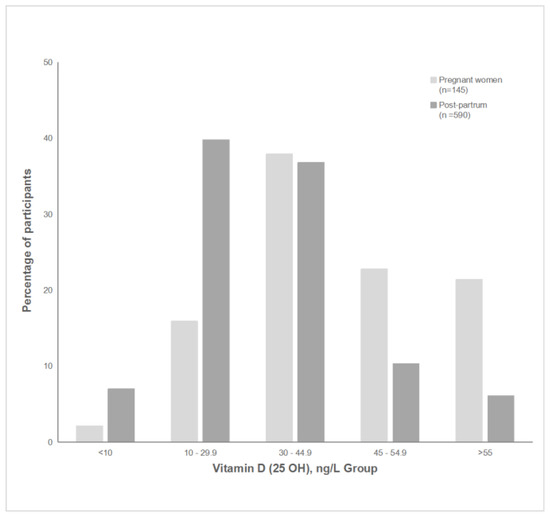
Figure 1
Open AccessArticle
Association between Adiposity and Bone Mineral Density in Adults: Insights from a National Survey Analysis
Nutrients 2023, 15(15), 3492; https://doi.org/10.3390/nu15153492 - 07 Aug 2023
Abstract
Adiposity and bone mineral density (BMD) are closely associated. The aim of this research was to investigate the association between BMD and adiposity measures in adults, including gynoid percent fat (GPF), android percent fat (APF), total percent fat (TPF), visceral adipose tissue percent
[...] Read more.
Adiposity and bone mineral density (BMD) are closely associated. The aim of this research was to investigate the association between BMD and adiposity measures in adults, including gynoid percent fat (GPF), android percent fat (APF), total percent fat (TPF), visceral adipose tissue percent (VAT%), and total lean mass percent (TLM%). Participants (n = 11,615) aged 18 years and older were analyzed using data from the National Health and Nutrition Examination Survey (NHANES) spanning from 1999 to 2018. Associations between BMD and adiposity measures were investigated, and potential differences based on gender and age were explored. Significant negative associations were observed among TPF, APF, GPF, VAT%, and BMD in the fully adjusted models, while TLM% and BMD were positively associated. Stratifying by age and sex, TPF, GPF, and VAT% consistently demonstrated a negative correlation with BMD. In the young adult group, a TPF of 38.2% eliminated the negative correlation between BMD and TPF. Male BMD exhibited an inverted U-shaped relationship with APF, peaking at 35.6%, while a similar pattern was observed for the middle-aged group BMD and APF, with a peak at 31.7%. This large-sample research found a significant negative association between adiposity measures and BMD, providing valuable revelations regarding the intricate connection between adiposity and bone health.
Full article
(This article belongs to the Special Issue Association between Metabolic Syndrome and the Musculoskeletal System)
►▼
Show Figures

Figure 1
Open AccessArticle
The Effect of the Rice Endosperm Protein Hydrolysate on the Subjective Negative Mood Status in Healthy Humans: A Randomized, Double-Blind, and Placebo-Controlled Clinical Trial
by
, , , , , , and
Nutrients 2023, 15(15), 3491; https://doi.org/10.3390/nu15153491 - 07 Aug 2023
Abstract
The rice endosperm protein (REP) hydrolysate containing the following rice endosperm protein derived oligopeptides QQFLPEGQSQSQK, LPEGQSQSQK, and pEQFLPEGQSQSQK (a N-terminal pyroglutamate residue-modified peptide) reportedly showed an antidepressant-like effect in an animal model. We investigated the effect of the REP hydrolysate on healthy
[...] Read more.
The rice endosperm protein (REP) hydrolysate containing the following rice endosperm protein derived oligopeptides QQFLPEGQSQSQK, LPEGQSQSQK, and pEQFLPEGQSQSQK (a N-terminal pyroglutamate residue-modified peptide) reportedly showed an antidepressant-like effect in an animal model. We investigated the effect of the REP hydrolysate on healthy humans who self-reported mental fatigue with subjectively low vigor. Seventy-six participants (age: 20–64 years) were randomly allocated to two groups. The influence of the REP hydrolysate on the mood state was evaluated in two studies: single intake (Study 1) and repeated intake over 4 weeks (Study 2). A salivary stress marker, Chromogranin A (CgA), was measured in Study 1. The single intake of the REP hydrolysate significantly improved the Profile of Mood Status 2nd edition for adults (POMS 2) subscale of Tension–Anxiety. Additionally, the salivary CgA concentrations were remarkably reduced after the single intake of the REP hydrolysate. Though a single intake of the REP hydrolysate did not significantly influence the other subscales and the TMD of the POMS 2 and the Euthymia Scale, both the subjective and objective results supported the possible effect of the REP hydrolysate on reducing anxiety and nervousness. No significant positive effects on the subjective mood state (Euthymia Scale and POMS 2) and sleep quality (Insomnia Severity Index) were observed in the trial setting employed for Study 2. In conclusion, a single intake of REP hydrolysate might help relax the subjective feelings of tension and anxiety. The effectiveness of repeated REP hydrolysate intake needs to be tested in a different clinical setting.
Full article
(This article belongs to the Section Clinical Nutrition)
►▼
Show Figures
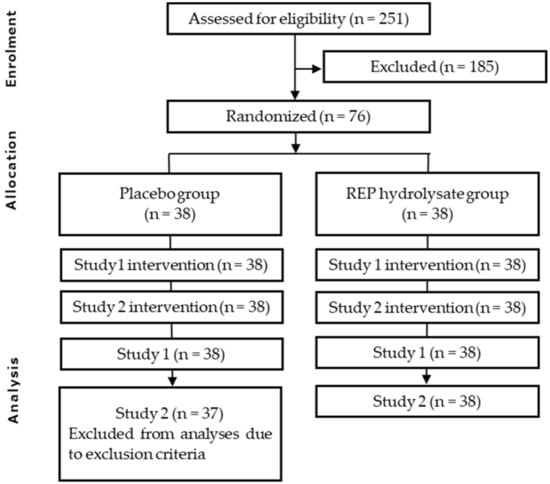
Figure 1
Open AccessArticle
Fermentation and Quality Characteristics of Yogurt Treated with Bifidobacterium longum
Nutrients 2023, 15(15), 3490; https://doi.org/10.3390/nu15153490 - 07 Aug 2023
Abstract
The fermentation and quality characteristics of yogurt were investigated according to the inoculation concentration of Bifidobacterium longum. The total sugar content of yogurt decreased as the fermentation time increased, and with an increased concentration of B. longum treatment the fermentation time decreased
[...] Read more.
The fermentation and quality characteristics of yogurt were investigated according to the inoculation concentration of Bifidobacterium longum. The total sugar content of yogurt decreased as the fermentation time increased, and with an increased concentration of B. longum treatment the fermentation time decreased rapidly. As fermentation progressed, the lactose content decreased rapidly at the beginning and gradually decreased as the pH decreased. Depending on the B. longum treatment concentration, the lactose content varied from 0.29 ± 0.01 to 0.47 ± 0.01% and was 0.5% or less in all experimental groups. The experimental group inoculated with 0.0015% of B. longum displayed the best results in all categories, including pH, total acidity, lactic acid content, solid non-fat content, and total lactic acid bacteria count, which are factors that determine the quality of yogurt. In summary, the experimental group inoculated with 0.0015% of B. longum was determined to be the highest quality yogurt.
Full article
(This article belongs to the Section Prebiotics and Probiotics)
►▼
Show Figures

Figure 1
Open AccessArticle
Construction of a QSAR Model Based on Flavonoids and Screening of Natural Pancreatic Lipase Inhibitors
Nutrients 2023, 15(15), 3489; https://doi.org/10.3390/nu15153489 - 07 Aug 2023
Abstract
Pancreatic lipase (PL) is a key hydrolase in lipid metabolism. Inhibition of PL activity can intervene in obesity, a global sub-health disease. The natural product is considered a good alternative to chemically synthesized drugs due to its advantages, such as low side effects.
[...] Read more.
Pancreatic lipase (PL) is a key hydrolase in lipid metabolism. Inhibition of PL activity can intervene in obesity, a global sub-health disease. The natural product is considered a good alternative to chemically synthesized drugs due to its advantages, such as low side effects. However, traditional experimental screening methods are labor-intensive and cost-consuming, and there is an urgent need to develop high-throughput screening methods for the discovery of anti-PL natural products. In this study, a high-throughput virtual screening process for anti-PL natural products is provided. Firstly, a predictable anti-PL natural product QSAR model (R2train = 0.9444, R2test = 0.8962) were developed using the artificial intelligence drug design software MolAIcal based on genetic algorithms and their conformational relationships. 1068 highly similar (FS > 0.8) natural products were rapidly enriched based on the structure-activity similarity principle, combined with the QSAR model and the ADMET model, for rapid prediction of a total of five potentially efficient anti-PL natural products (IC50pre < 2 μM). Subsequently, molecular docking, molecular dynamics simulation, and MMGBSA free energy calculation were performed to not only reveal the interaction of candidate novel natural products with the amino acid residues of PL but also to validate the stability of these novel natural compounds bound to PL. In conclusion, this study greatly simplifies the screening and discovery of anti-PL natural products and accelerates the development of novel anti-obesity functional foods.
Full article
(This article belongs to the Special Issue Computer Science in Human Nutritional Research and Health Applications)
►▼
Show Figures
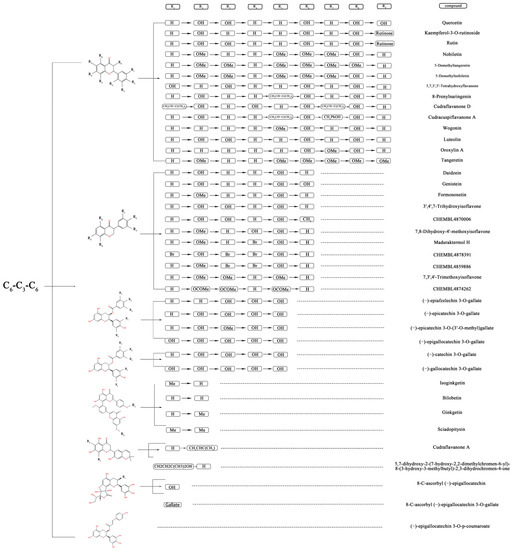
Figure 1
Open AccessArticle
Development and Validation of Nutrition Literacy Assessment Instrument for Chinese Lactating Women: A Preliminary Study
by
, , , , , , , , , and
Nutrients 2023, 15(15), 3488; https://doi.org/10.3390/nu15153488 - 07 Aug 2023
Abstract
This study focused on the development and validation of a nutrition literacy assessment instrument for Chinese lactating women (NLAI-L). A comprehensive literature review and group discussion by experts in relevant fields were adopted to determine the dimension, topics and questions of NLAI-L. Content
[...] Read more.
This study focused on the development and validation of a nutrition literacy assessment instrument for Chinese lactating women (NLAI-L). A comprehensive literature review and group discussion by experts in relevant fields were adopted to determine the dimension, topics and questions of NLAI-L. Content validity was evaluated by a panel of experts. The exploratory factor analyses (EFA) and confirmatory factor analyses (CFA) were used to evaluate the construct validity. Cronbach’s α and split-half reliability were applied to examine the reliability of NLAI-L. The final NLAI-L consisted of 38 questions covering three dimensions: knowledge, behavior and skill. The EFA revealed four sub-domains for knowledge, one sub-domain for behavior and four sub-domains for skill. The results showed that NLAI-L had satisfactory content validity (CVI = 0.98, CVR = 0.96), good reliability (Cronbach’s α coefficient = 0.84) and acceptable construct validity (χ2/df = 2.28, GFI = 2.81, AGFI = 0.79, RMSEA = 0.057). In the application part, the average NL score was 46.0 ± 9.3. In multivariate linear regression, education level, age, postnatal period and occupation were the potential influencing factors of NL for Chinese lactating women. The study established an effective and reliable assessment instrument for Chinese lactating women (NLAI-L) through qualitative and quantitative methods. The establishment of NLAI-L will provide an effective tool for exploring the role of NL in health or disease and provide a basis for the formulation of targeted nutrition interventions.
Full article
(This article belongs to the Special Issue China National Nutrition Survey: 2nd Edition)
►▼
Show Figures
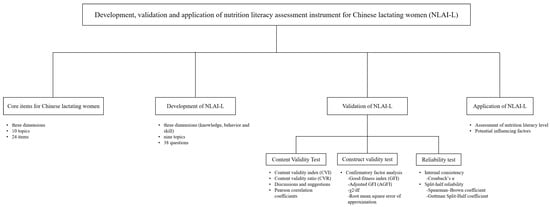
Figure 1
Open AccessReview
Evaluation and Management of Nutritional Consequences of Chronic Liver Diseases
by
, , , , and
Nutrients 2023, 15(15), 3487; https://doi.org/10.3390/nu15153487 - 07 Aug 2023
Abstract
Liver diseases are the major predisposing conditions for the development of malnutrition, sarcopenia, and frailty. Recently, the mechanism of the onset of these complications has been better established. Regardless of the etiology of the underlying liver disease, the clinical manifestations are common. The
[...] Read more.
Liver diseases are the major predisposing conditions for the development of malnutrition, sarcopenia, and frailty. Recently, the mechanism of the onset of these complications has been better established. Regardless of the etiology of the underlying liver disease, the clinical manifestations are common. The main consequences are impaired dietary intake, altered macro- and micronutrient metabolism, energy metabolism disturbances, an increase in energy expenditure, nutrient malabsorption, sarcopenia, frailty, and osteopathy. These complications have direct effects on clinical outcomes, survival, and quality of life. The nutritional status should be assessed systematically and periodically during follow-up in these patients. Maintaining and preserving an adequate nutritional status is crucial and should be a mainstay of treatment. Although general nutritional interventions have been established, special considerations are needed in specific settings such as decompensated cirrhosis, alcohol-related liver disease, and metabolic-dysfunction-associated fatty liver disease. In this review, we summarize the physiopathology and factors that impact the nutritional status of liver disease. We review how to assess malnutrition and sarcopenia and how to prevent and manage these complications in this setting.
Full article
(This article belongs to the Special Issue Nutritional Support in Digestive Diseases, and Nutritional Implications of Dietary Interventions)
►▼
Show Figures
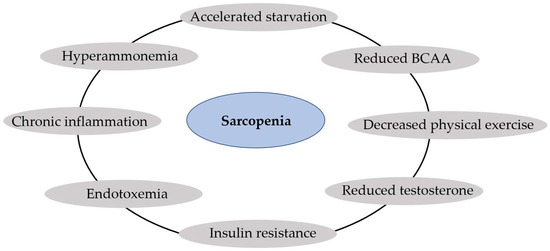
Figure 1
Open AccessArticle
Associations of Dietary Intake and Nutrient Status with Micronutrient and Lipid Composition in Breast Milk of Donor Women
by
, , , , , , , , and
Nutrients 2023, 15(15), 3486; https://doi.org/10.3390/nu15153486 - 07 Aug 2023
Abstract
The influence of the diet and nutritional status of milk donors on the nutritional composition of donor human milk (DHM) is unknown. The present study aimed to determine the nutritional profile of DHM and the associations between donors’ dietary intake and nutritional status
[...] Read more.
The influence of the diet and nutritional status of milk donors on the nutritional composition of donor human milk (DHM) is unknown. The present study aimed to determine the nutritional profile of DHM and the associations between donors’ dietary intake and nutritional status and the micronutrient and lipid composition in DHM. For this purpose, 113 donors completed a food frequency questionnaire, provided a five-day weighed dietary record, and collected milk for five consecutive days. Nutrient determinations in donors’ erythrocytes, plasma, urine, and milk were performed. Multiple linear regressions were conducted for the evaluation of the associations. We highlight the following results: DHM docosahexaenoic acid (DHA) was positively associated with donors’ plasma DHA content and donors’ DHA intake (R2 0.45, p < 0.001). For every 1 g/day DHA intake, an increase of 0.38% in DHA content and 0.78% in total omega-3 content was observed in DHM (R2 0.29, p < 0.001). DHM saturated fatty acids were positively associated with erythrocyte dimethyl acetals, plasma stearic acid, trans fatty acids intake, and breastfeeding duration and negatively associated with erythrocyte margaroleic acid (R2 0.34, p < 0.01). DHM cholecalciferol was associated with plasma cholecalciferol levels and dairy intake (R2 0.57, p < 0.01). Other weaker associations were found for free thiamin, free riboflavin, pyridoxal, dehydroascorbic acid, and the lipid profile in DHM. In conclusion, the diet and nutritional status of donors influence the fatty acid profile and micronutrient content of DHM.
Full article
(This article belongs to the Section Pediatric Nutrition)
►▼
Show Figures

Figure 1

Journal Menu
► ▼ Journal Menu-
- Nutrients Home
- Aims & Scope
- Editorial Board
- Reviewer Board
- Topical Advisory Panel
- Instructions for Authors
- Special Issues
- Topics
- Sections & Collections
- Article Processing Charge
- Indexing & Archiving
- Editor’s Choice Articles
- Most Cited & Viewed
- Journal Statistics
- Journal History
- Journal Awards
- Society Collaborations
- Conferences
- Editorial Office
Journal Browser
► ▼ Journal BrowserHighly Accessed Articles
Latest Books
E-Mail Alert
News
Topics
Topic in
Gastroenterology Insights, Gastrointestinal Disorders, JCM, Microorganisms, Nutrients
Gut Microbiota in Human Health
Topic Editors: Peng Chen, Xingyin Liu, Wenke FengDeadline: 31 August 2023
Topic in
Antioxidants, BioChem, Biomolecules, Cells, IJMS, Nutrients, Pharmaceutics, Foods
Bioactive Compounds with Application Potentials in Nutraceuticals and Nutricosmetics: Focus on Mechanism of Action and Application Science
Topic Editors: Pujie Shi, Tiantian Lin, Lin Chen, Xin Yang, Caili Fu, Hyun-Gyun Yuk, Rong FanDeadline: 30 September 2023
Topic in
Gastroenterology Insights, JCM, Livers, Nutrients, Reports
Multiple Organ Cross-Talk and Nutrition Metabolism in the Development and Progression of NAFLD / MAFLD
Topic Editors: Atsushi Nakajima, Masato YonedaDeadline: 20 October 2023
Topic in
Dietetics, Foods, Horticulturae, Nutrients, Plants
Edible Plants as Sources of Polyphenols: Cultivation Techniques, Extraction, and Nutraceutical Applications
Topic Editors: Luana Beatriz dos Santos Nascimento, Cecilia Brunetti, Antonella GoriDeadline: 20 December 2023

Conferences
Special Issues
Special Issue in
Nutrients
Regulatory Role of Vitamin D and Its Derivatives in the Immune System
Guest Editors: Jörg Reichrath, Andrzej Slominski, Michael F. HolickDeadline: 10 August 2023
Special Issue in
Nutrients
Evolution, Current Reality and Future of Dietary Assessment
Guest Editor: Anne-Kathrin IllnerDeadline: 20 August 2023
Special Issue in
Nutrients
Dietary Supplements in Cardiovascular and Metabolic Diseases
Guest Editors: Bruno Trimarco, Gaetano SantulliDeadline: 31 August 2023
Special Issue in
Nutrients
Mediterranean Nutrients and Oils
Guest Editors: Adil El Midaoui, Gérard LizardDeadline: 15 September 2023
Topical Collections
Topical Collection in
Nutrients
The Role of Nutrition in Exercise and Sports
Collection Editors: Roberta Ceci, Guglielmo Duranti
Topical Collection in
Nutrients
Connection between Microbiome, Lifestyle and Diet
Collection Editors: Eva Untersmayr, Peter M. Abuja
Topical Collection in
Nutrients
Food Supplements and Functional Foods Assessment for Health and Nutrition
Collection Editors: Laura Domínguez Díaz, Montaña Cámara, Virginia Fernández-Ruiz
Topical Collection in
Nutrients
Nutrition for Brain Development and Repair
Collection Editor: Stephane V. SizonenkoConference Reports
Nutrients 2023, 15(11), 2451; https://doi.org/10.3390/nu15112451
Nutrients 2018, 10(1), 8; https://doi.org/10.3390/nu10010008


















